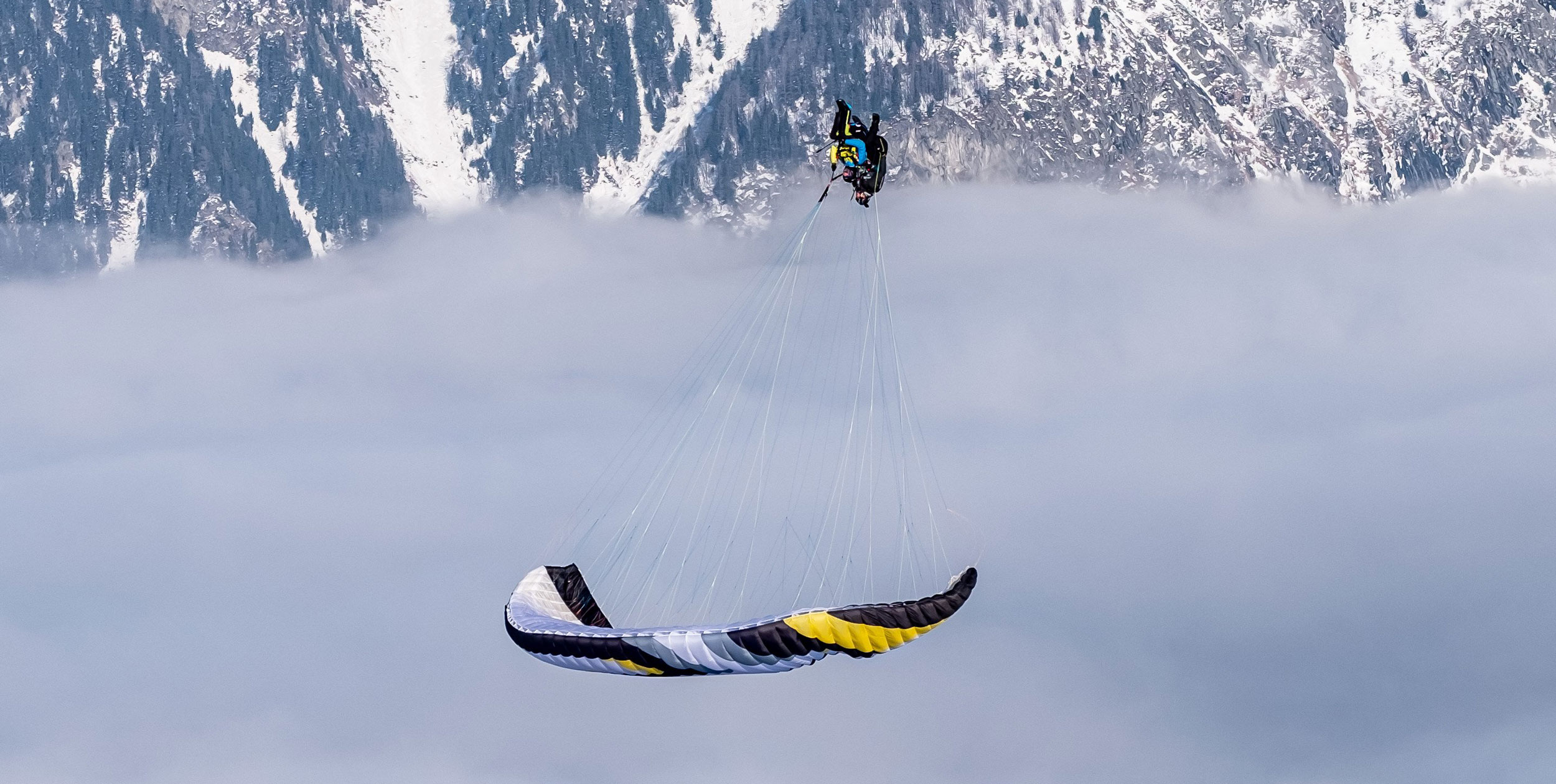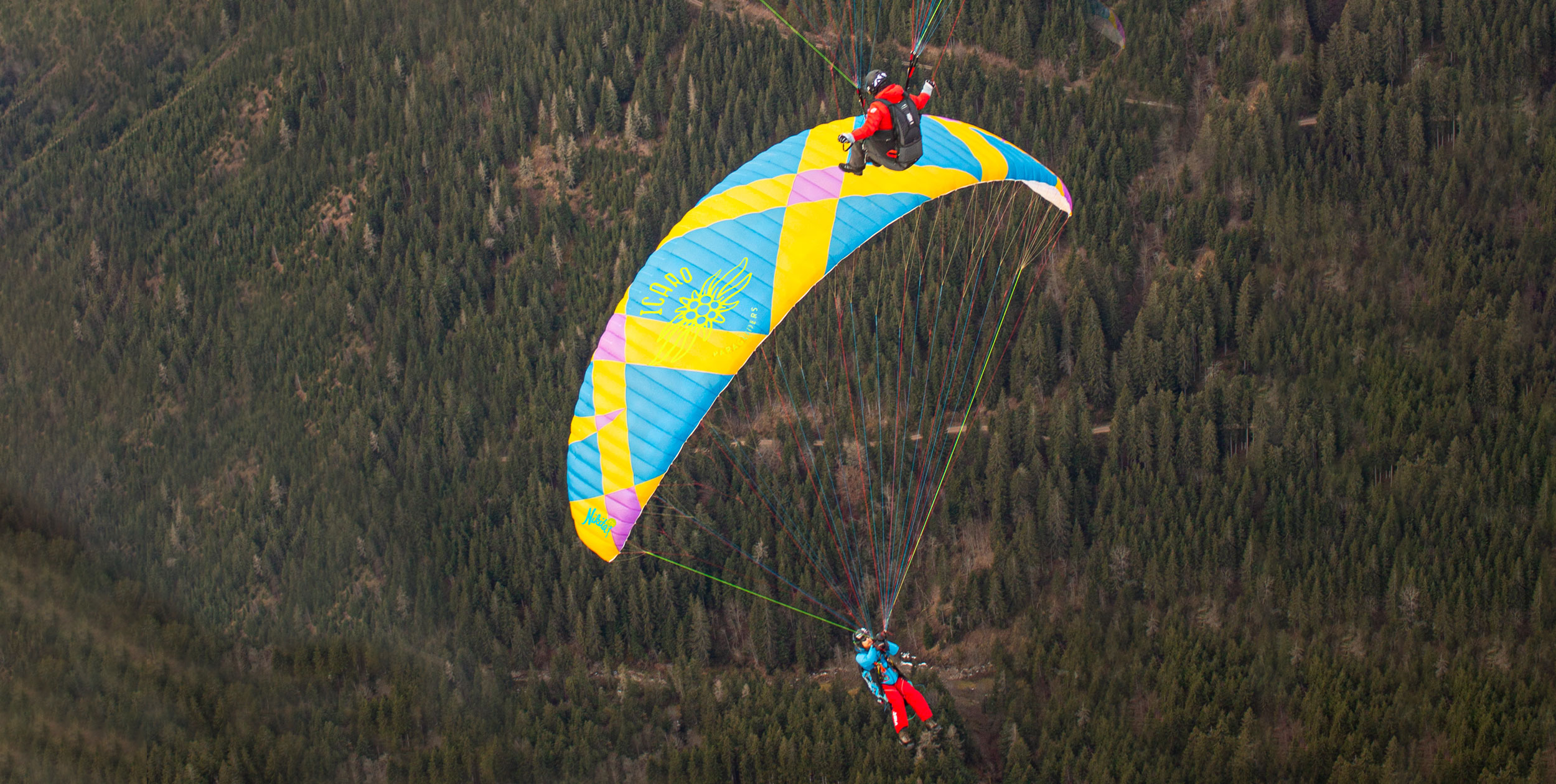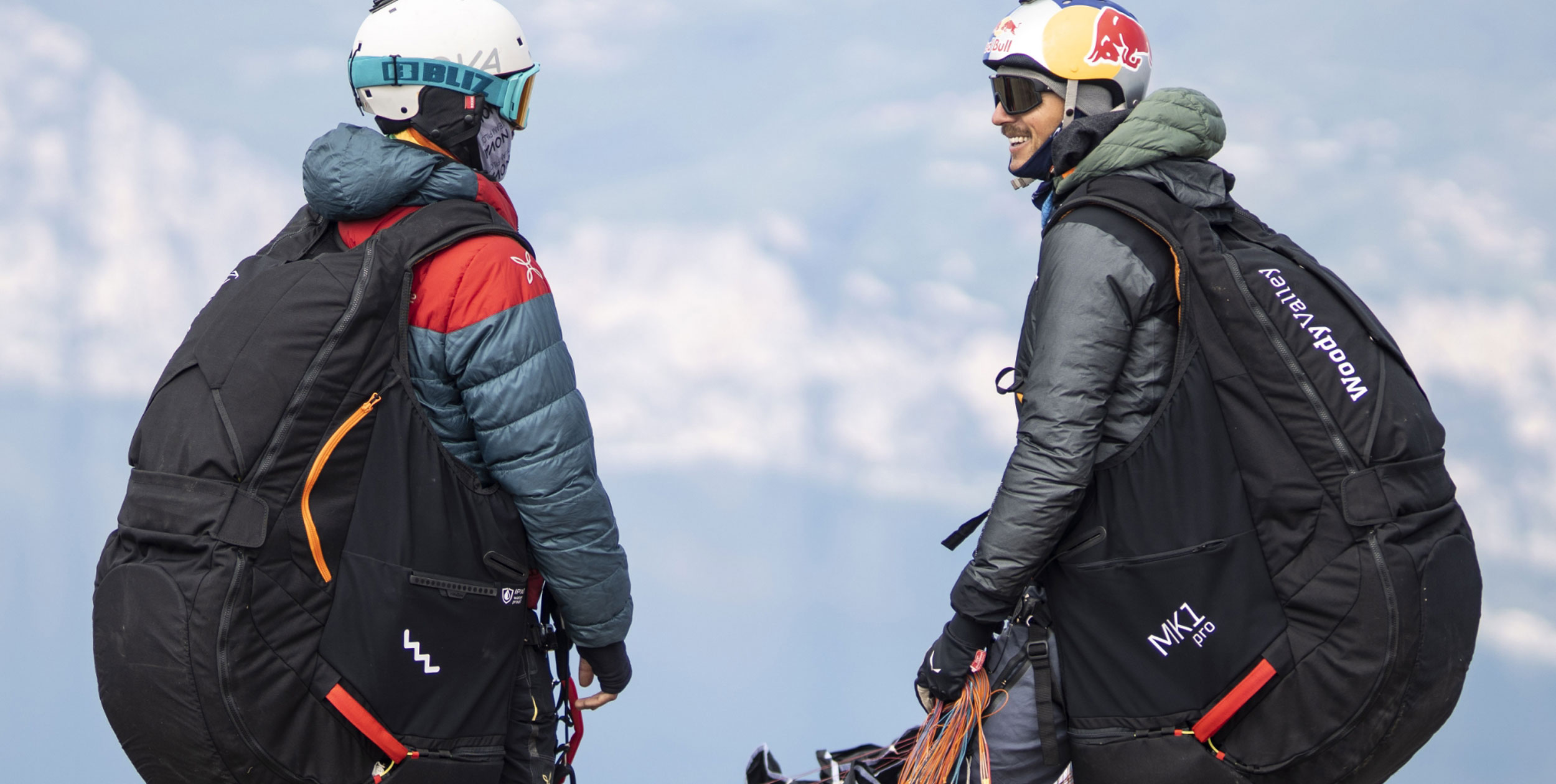Enleau O Connor’s SIV and acro paragliding video, Broken Toe Acro
In Richard Bach’ famed novel, Johnathon Livingston Seagull returns to his flock to teach other gulls the delights of perfecting aerobatics. He and his squadron of young gulls are shunned by the flock, and dismissed as outcasts. In a similar manner, many governing bodies in paragliding have cold-shouldered aerobatics and discredited those who attempt to teach others the art. Matt Gerdes questions current attitudes towards professional aerobatics clinics. First published in Cross Country magazine 2002
Its 8:15 am at a small lake in Northern California. A group of pilots are loading glider bags and coolers into two boats, and in the background a harness hangs from a simulator mounted to the back of a caravan. There isn’t a hill in site, but the pilots look eager, wringing their hands from the cold and the anticipation. They gather round the simulator for the morning briefing, and then pile into the boats, which are equipped with custom-built hydraulic pay-out winches. After arriving at a sandy beach across the lake, they begin to lie out their gliders.
A few minutes later, and a few thousand feet above the lake, the radio buzzes to life in Wess ear…”And….. NOW!” With his left hand pushing firmly against his left riser to hold in his right weightshift, Wes wrenches down on his right brake at his instructors command. Already screaming out of an asymmetric spiral, the tremendous amount of brake input and opposite weightshift causes his glider to dive beneath him, and he tumbles over the top of it. In a split second he looks up and sees his glider and the lake, below his feet he sees the sky. As the horizon comes back to where it should be, Wes checks the outside brake to stop the tumble and lets his glider dive to recover speed, returning to level flight.
The Instructor, Enleau O Connor, is standing on the beach with radio in hand, staring up at Wes intently. He says, “Nice work, but you almost let yourself get blown out of your posture, youve got to hold it in. Come back towards shore and well do another.”
Wes enters an asymmetric spiral from a wingover, and as his glider levels through the bottom of the turn he throws it in to another Tumble. His posture and timing are right on, evidenced by his glider diving swiftly and with even pressurization.
Again, he tumbles over the top, eases it over into a SAT, and settles back to level flight. “Great, come on back for a spin landing.” He flies back to shore, burying his right brake for a negative spin about five feet off the sand in lieu of a flare. He plops down on his feet, facing his glider, which has settled perfectly, leading edge up.
Enleau nods, and walks over to the next pilot in line, who is laying out her glider in preparation for the boat tow launch. Its Kari Castle, world-renowned hang glider pilot, here to hone her paragliding skills.
“OK, we talked about SAT posture earlier, lets be sure you understand it.” Enleau explains the posture and timing in detail as he connects her tow bridle to the line. She adjusts her life vest, and gives the signal to the driver. The boat driver guns it, Kari pulls up her glider, and is off. She adds a little left brake to take up some slack in the line and starts gaining altitude.
As the boat circles around the lake towing Kari up to almost 3000agl, Enleau explains the dynamics of the SAT to some of the first-time pilots at the clinic. Among those listening attentively is Nick Peterson, a 21-year-old boat builder who travelled 2000 miles in his VW bus to paraglide the Western US, and Jerry, a 40-something software developer back for his sixth clinic. Both are equally keen on Aerobatics and have come to Enleau to have the secrets of paragliding manoeuvres revealed to them in a safe environment.
This is the future of aerobatics. For around $200 dollars a day, these pilots are learning to SAT, Helicopter, Asymmetric spiral, Loop and Tumble. “Many pilots who feel comfortable in spirals and have good glider management can look forward to learning a SAT at one of my clinics,” Enleau says. “Some are back for the fifth and sixth time, and are learning to Loop and Tumble, but those manoeuvres require much experience and practice.”
Out over the lake, Kari is beginning a right hand spiral with massive inside weightshift and a full wrap and a half on the inside brake. Enleau talks her through her first SAT via radio step by step.
“Wrap and a half on the right brake, least amount of brake on the left, get your posture, lean in for all youre worth, and, NOW! PULL, PULL, PULL”
Karis Quarx tips into the SAT and we can almost see her smile from shore. She SATs for about six revolutions and shuts it down with opposite brake for a gentle exit. The other pilots watching (nine in total) congratulate her after she lands.
Enleau has been teaching manouvres full time over the past four years, and with support from Chris Santacroce and Superfly Inc., Enleau has managed to accumulate enough students to make a living teaching manoeuvres and aerobatics. And hes not alone. In the past years, a handful of people have gone beyond the typical “manoeuvres clinic” itinerary, and have begun to teach aerobatics, despite widespread criticism from some governing bodies.
The famous Rodriguez brothers are teaching aeros to pilots in Europe and South America, Mike Kung is providing safety training courses in Turkey every summer, and Chris Santacroce is also teaching in America. Indeed, there are already hundreds of pilots worldwide who have already learned the SAT, and not from studying the sequences in magazines or videos.
All of the pilots present at this “manoeuvres” clinic are here by word of mouth or email, as USHGA, which publishes the monthly US magazine Paragliding, has refused to advertise Enleaus clinics. Regarded as a kind of black sheep by the USHGA, Enleau exists at the mercy of his perfect safety record: over 500 pilots towed and trained, and not a single injury.
While the USHGA may not have entirely approved of Enleau’s decision to begin teaching the SAT, and other more difficult manoeuvres, it has not been so bold as to intervene or even make public its concerns. Recently however, Enleau has begun to come in from the cold, mainly because of the total success of his clinics.
Chris Santacroce has been teaching PG manouvers since 1994, and the SAT since late 2000. He has taught countless pilots how to spin and stall their gliders, and several to loop and helicopter. Chris stated that “USHGA is wise not to endorse aerobatics or aerobatic training. It is simply not their place. …The only need for organization in PG aerobatics would be to promote the pursuit, certify coaches, solicit sponsorship, and organize events.
Dont be surprised if one emerges shortly. Also, most paraglider owner’s manuals state that pilots should avoid excessive bank. It isnt that all manufacturers dont believe that the glider is capable of excessive bank, its that they cant go on the record as being in support of said activity. The pursuit of aerobatics in an aircraft that changes shape is very abstract, although still very reasonable under the correct circumstances.”
So the controversy stems, seemingly, from just one issue: safety. While the safety of virtually anything is relative to the manner in which it is practiced, I asked Mike Kung his opinion of the safety of aerobatics in paragliding. Not many pilots in the world have as solid a background in aeros as Mike. With nearly ten years experience as a paraglider test pilot, he is as familiar with paraglider dynamics as any pilot in the world.
He says there is two core issues affecting the safety of aerobatics: equipment, and the pilots willingness to follow a natural progression. When asked about whether or not the equipment being manufactured right now is suitable for aerobatics, he said “most of the companies today are doing a very good job with construction, and the materials being used are great. I think all of the equipment failure problems we have seen so far have been a result of inadequate inspections, pilots not getting the necessary equipment checks.
I think once a year is the minimum, more for pilots who put excessive wear on their gliders. Your equipment must be in the highest condition, lines, glider, harness, everything. Your Reserve must be packed properly, all of these things you must have if you want to move on to aerobatics. Equipment checks are crucial. We have measured the G forces of the most intense manoeuvres, and we have reached nearly 5 Gs in the loop-entry tumble.
“Also, it is very important for the pilots to not move too fast in trying new manoeuvres. The SAT is much like a spiral, and I think many pilots can learn it no problem, but the newer manoeuvres like the Tumbles and Ass-choppers[Mc Twists] are really hot stuff, and are really only for the most current aerobatics pilots, pilots that are flying [aerobatics] everyday.
“I know many very good pilots who say that they stop at the SAT, because the new manoeuvres are really too rough. …there is no room for mistakes in a Tumble or Ass chopper, even the Helicopter can be very aggressive.
“With the new manoeuvres, there are many times when the pilot is way above his glider, and the chances of hitting the canopy are very high. I always make sure that I perfect a manoeuvre before going on to another.
“It is very important for me to do the manoeuvre perfectly, with complete control. I think it is always better to do an older manoeuvre perfectly than to do a newer one with less control. Pilots must have respect for the manoeuvres, and progress slowly.
“In my courses I make sure that pilots have mastered the basic manoeuvres and know the deep stall points on their glider, without going into stall, and have good ground handling skills.”
Few sports require such extensive training and instruction, largely because few sports hold such dire consequences for mistakes. Thankfully, there have been a very small number of injuries and fatalities to date in aerobatics.
Some say this is due only to the small number of pilots doing them, but most think it is because the majority of those pilots possess the skill necessary to keep themselves safe. Enleau OConnor and Chris Santacroce share the same view of how aerobatics should be practiced- over the water, with a life vest and a rescue boat.
But these conditions are rarely seen outside of an organized manoeuvres clinic, which doesnt happen every day, and usually costs several hundred dollars for a weekend. So it would seem likely that pilots would continue to practice over the dirt, at their home sites.
Chris said “I think that pilots who learn over the water and would continue on their own over the dirt are crazy. The people that do aeros over the dirt on a regular basis have experience that can only come from flying every day for years and years.
“The average pilot can never get that amount of experience without quitting their jobs and families. I still only like to do new tricks over the water, and if Im not current, I always get current over the water, under the watchful eye of my friends, until we all agree that we are doing the manoeuvres in a predictable manner.
“Then, if the manoeuvre takes place over the dirt, the pilot has to fully embrace the possibility that he/she might need to throw his/her reserve and have a nice place to land under it. The most important thing is to recognize the value of progression. The formula for success is to cast aside ambition and just go out and repeat what is familiar, and over time, we progress naturally.”
“We need organized, over-the-water opportunities available for pilots with all of the key elements, including good coaches, ” states Chris Santacroce. “We need to keep flying newer gliders from manufacturers that believe in aerobatics (even if the owners manuals dont say so). We need to realize that its not all about aerobatics or acro; its about figuring out that when you fly over the water you get the opportunity to work hard at repeating the manoeuvres that are important to you.
“Depending on your experience level, it may be Big Ears, or it may be. Either way, when you go back and fly over the dirt, you will be a safer pilot who will have more fun because of the over-the-water experience.
“Flying over the water provides a margin for error that allows the pilot to feel more at ease. When we are at ease, we perform better and we have more fun!”
Aerobatics fever is spreading rapidly throughout the world, and rarely do you find a pilot who hasn’t at least heard of the SAT. No one can doubt that aerobatics has a future. If the current trend of quality instruction continues, we can look forward to it becoming a very significant, and positive, part of our sport. The value of aeros shouldnt be doubted either, especially by those that care to see the sport of paragliding grow. Paragliding was anything but a spectator sport before aerobatics, which now has the potential to push our sport into the mainstream media, and into the public’s attention.
CLINICS
Clinics are happening more and more often around the world. Virtually everyone interviewed for this article mentioned that a pilot should choose their instructors carefully, as some are better than others.
Superfly Inc.s Chris Santacroce hosts clinics regularly in the American West. info@4Superfly.com
Enleau O Connor can be reached at gonetowing@hotmail.com. He will be hosting clinics in the US regularly, and possibly Europe in the spring of 2002 contact aerocamps@hotmail.com. Mike Kung hosts safety training clinics every year in Turkey. Both of his clinics scheduled this summer are already full. But check out www.madmikekung.com
A new manoeuvre was recently discovered by Enleau O Connor, who christened it the ESP. The move is an unorthodox recovery from a cravat. Enleau says, “Say you get a huge cravat on the right side: To use the ESP to solve it, immediately lean right, throw a right SAT, and continue with the brake to spin if necessary.
“The ESP has repeated solved cravats of such magnitude that they might only have been remedied by reserve deployment, and it has even worked to solve a Line-over on one pilot’s glider. The SAT creates a unique airflow around the glider that consistently blows out the cravat. If the SAT alone doesnt work, simply continuing to pull brake to enter a spin almost always does.
“If you get a massive cravat, you can throw your reserve, or throw the ESP!” While the everyday usefulness of this manoeuvre is obviously questionable, it is an exciting alternative for the most proficient pilots.
Updated January 2011
• Got news? Send it to us at news@xccontent.local
Subscribe to the world’s favourite hang gliding and paragliding magazine







